Biology 30 - Unit 1 Booklet 1: The Nervous System (Questions)
1/80
There's no tags or description
Looks like no tags are added yet.
Name | Mastery | Learn | Test | Matching | Spaced |
|---|
No study sessions yet.
81 Terms
What are the main divisons of the nervous system?
The CNS and the PNS
What are the two different types of nerve cells?
Glial cells and neurons

1
Dendrite
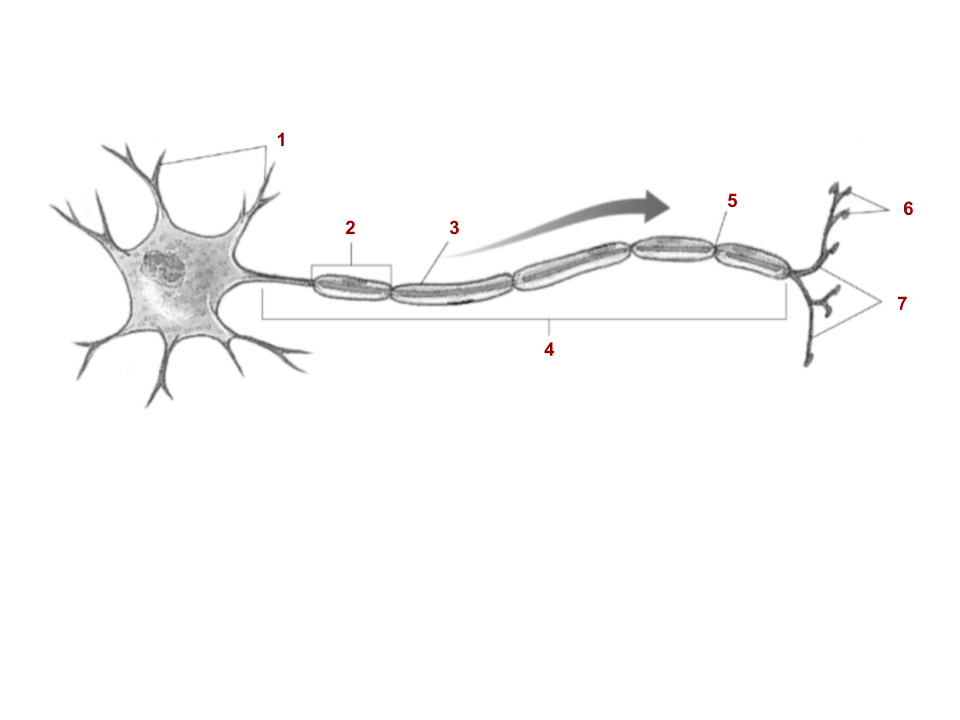
2
Schwann cell
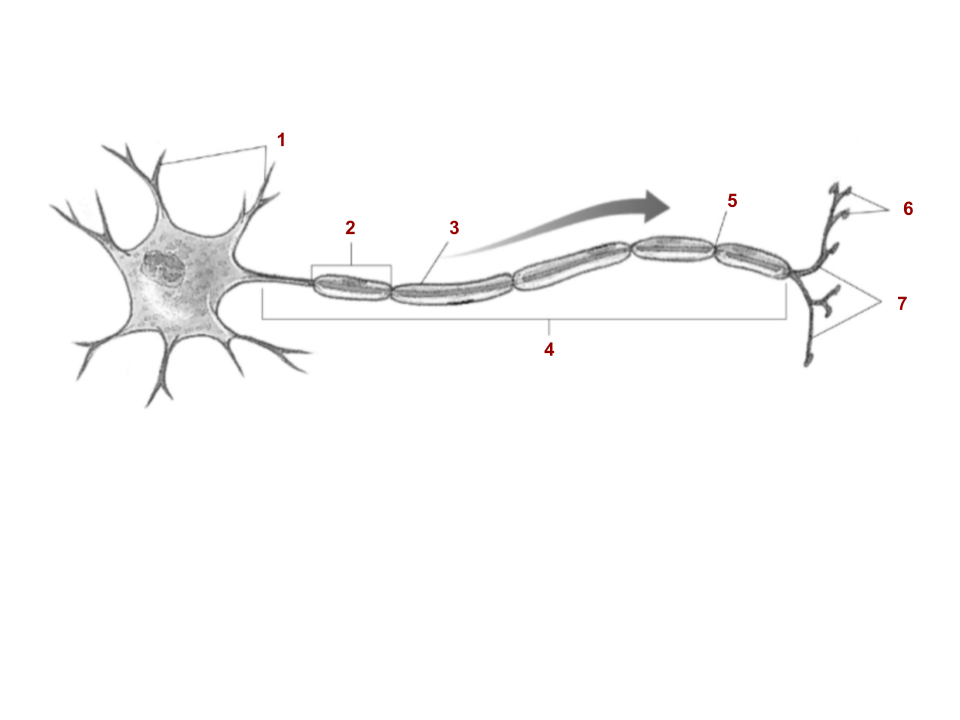
3
Myelin sheath
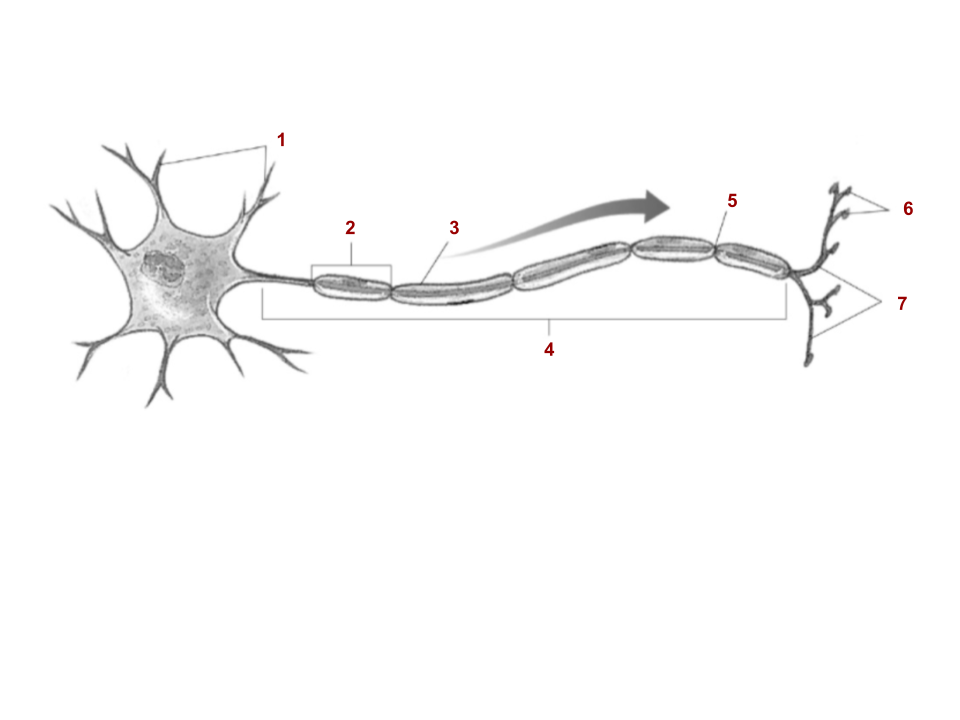
4
Axon

5
Node of Ranvier
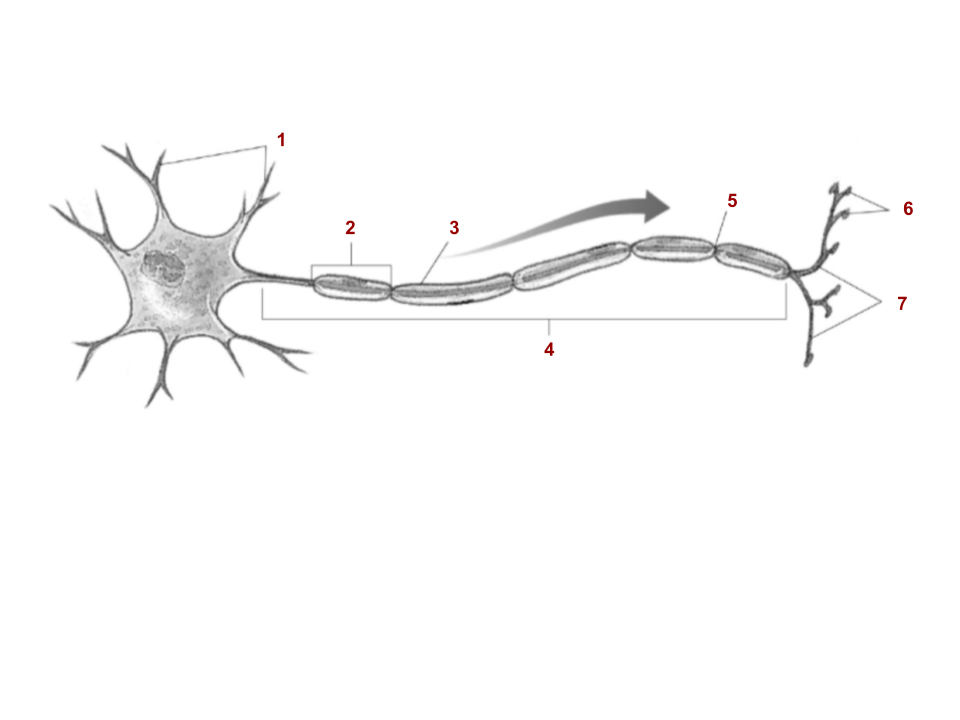
6
Endplates
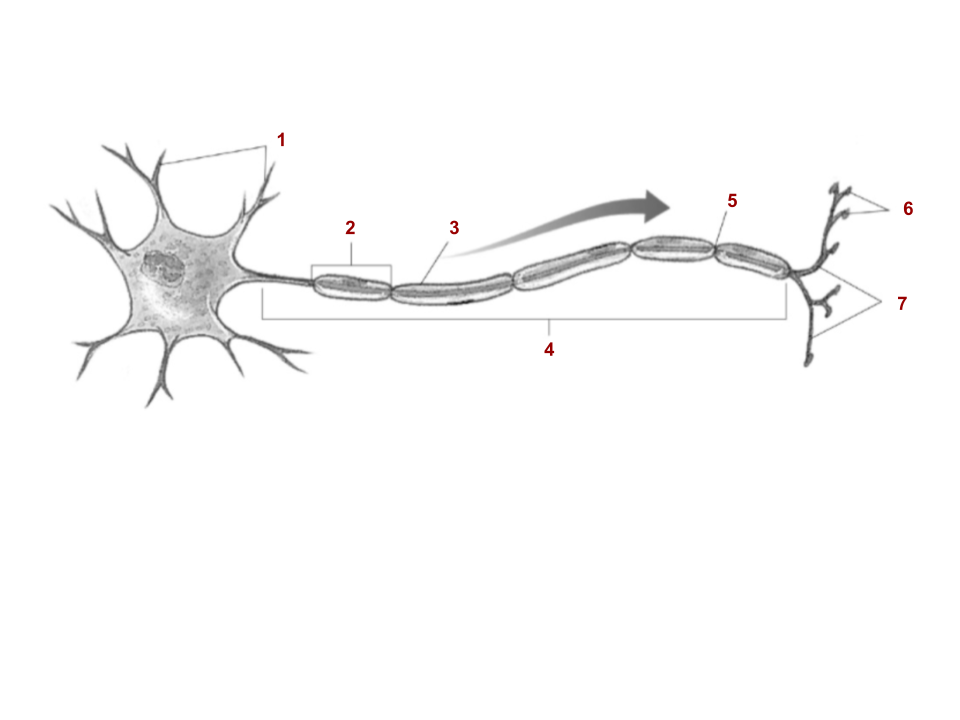
7
Terminal branches
From where do nerve impulses come from, and where do they go to?
Dendrite to axon
On what nerves is the myelin sheath found?
All PNS neurons and some CNS neurons
Where are schwann cells found?
Nerve cells in PNS
Where is the neurilemma found?
Only in the PNS
What are the categories of neurons based on their function?
Sensory neurons, interneurons, and motor neurons
Where are sensory neurons found?
Located in ganglia outside spinal cord
Where are interneurons found?
Only in the brain and spinal cord
Why does the reflex arc not involve coordination by the brain?
There is often not enough time to process and think about the dangerous stimulus because it will cause instantaneous harm (eg. burn)
What signals are sent by the reflex arc?
A primary response is hard wired through the spinal cord, and a secondary signal is sent to the brain
What is the process of the reflex arc?
Sensory receptor is activated by stimulus
Sensory information is received by sensory neuron and relayed to spinal cord
Sensory information is received by interneurons in the spinal cord
Sensory information is received by the motor neuron
Motor neuron is activated, causing action of the effector
How are electrochemical impulses created?
The movement of ions (particularly K+ and Na+) creates a current via a difference of charge
How is a concentration gradient created during the resting potential?
A sodium-potassium proton pump transports 2 K+ into the cell with every 3 Na+ transported out of the cell, making the outside of the cell more positive
Describe what is happening during the resting potential of a nerve cell (parts at work, quantities of ions, charge of inner membrane and ECF).
There is a proton pump working to pump 3 Na+ outside the cell and 2 K+ inside the cell. Sodium and potassium each have their own channels but they are closed. There are more Na+ ions outside the cell and more K+ ions inside the cell. The outside is more positive than the inside.
What is the resting potential of the inside of the nerve membrane?
-70 mV
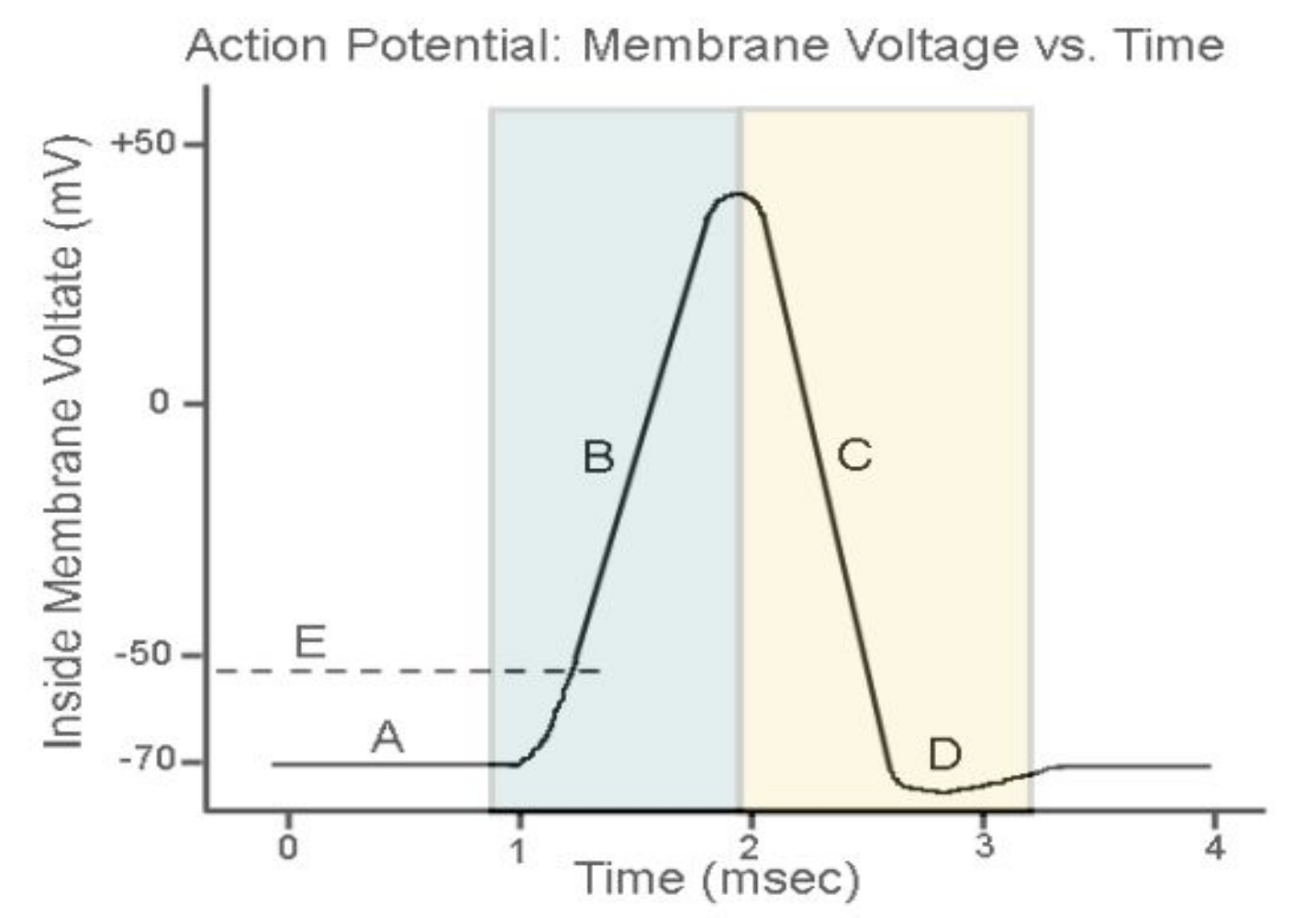
A
Resting potential
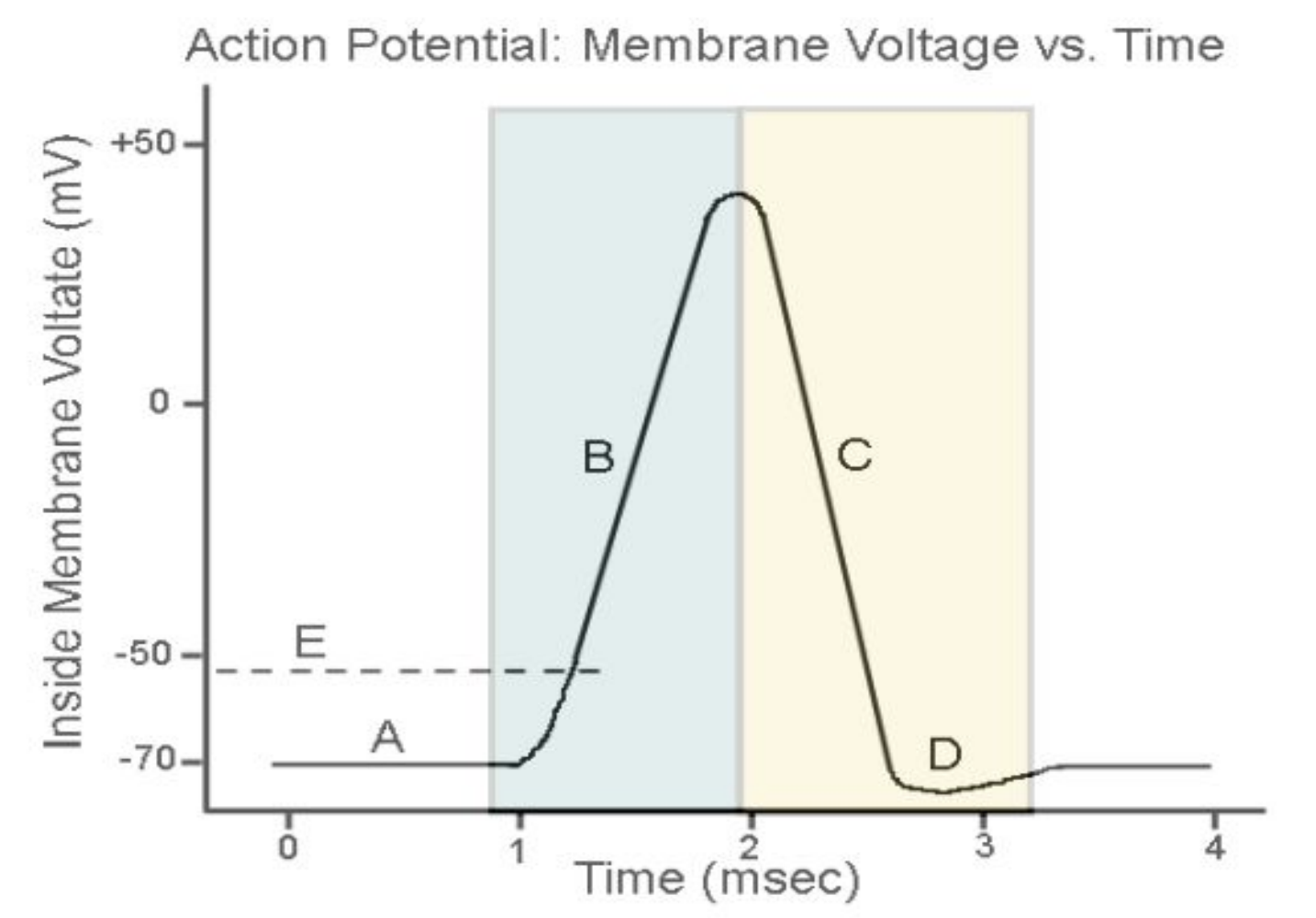
B
Depolarization
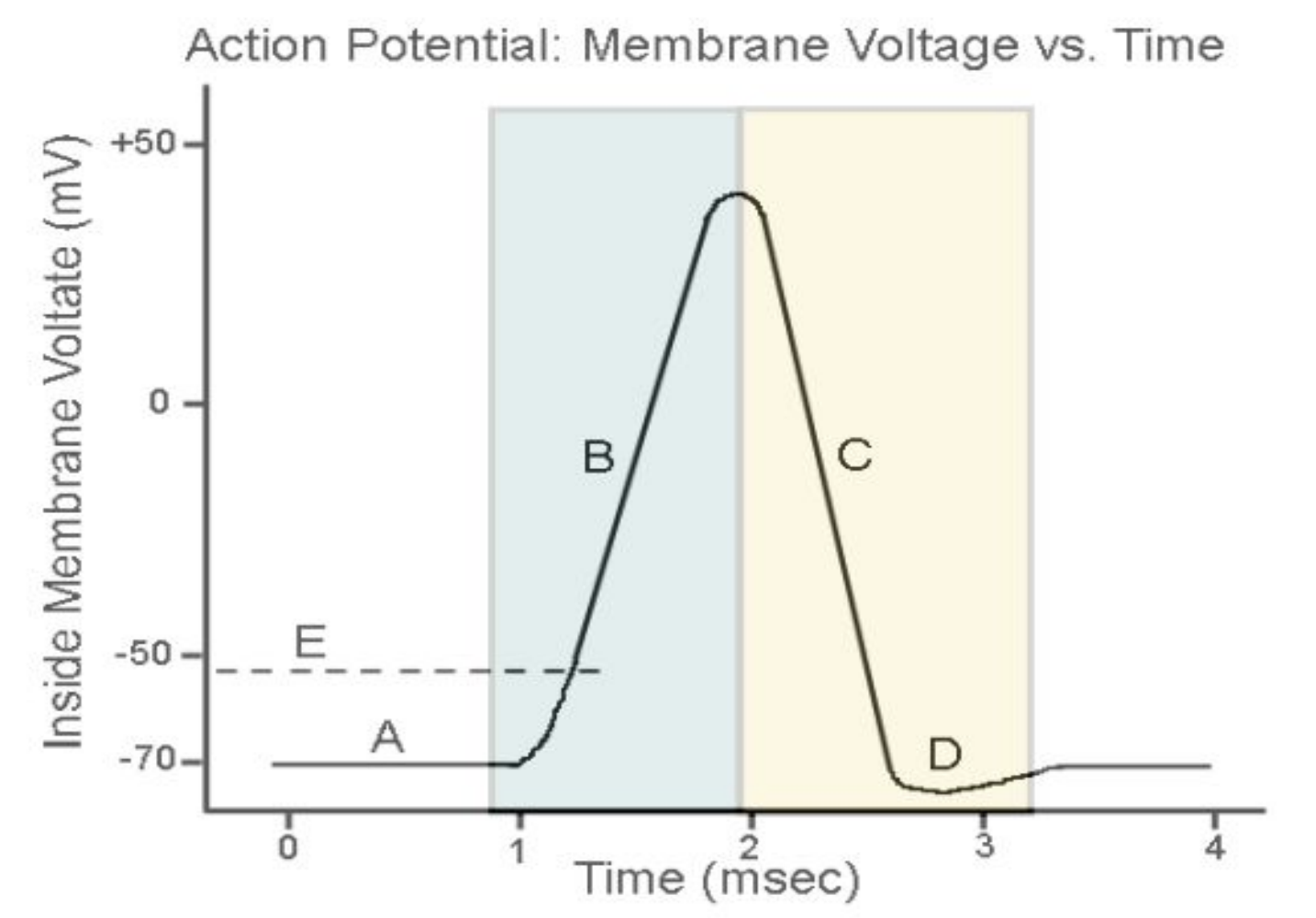
C
Repolarization/refractory period
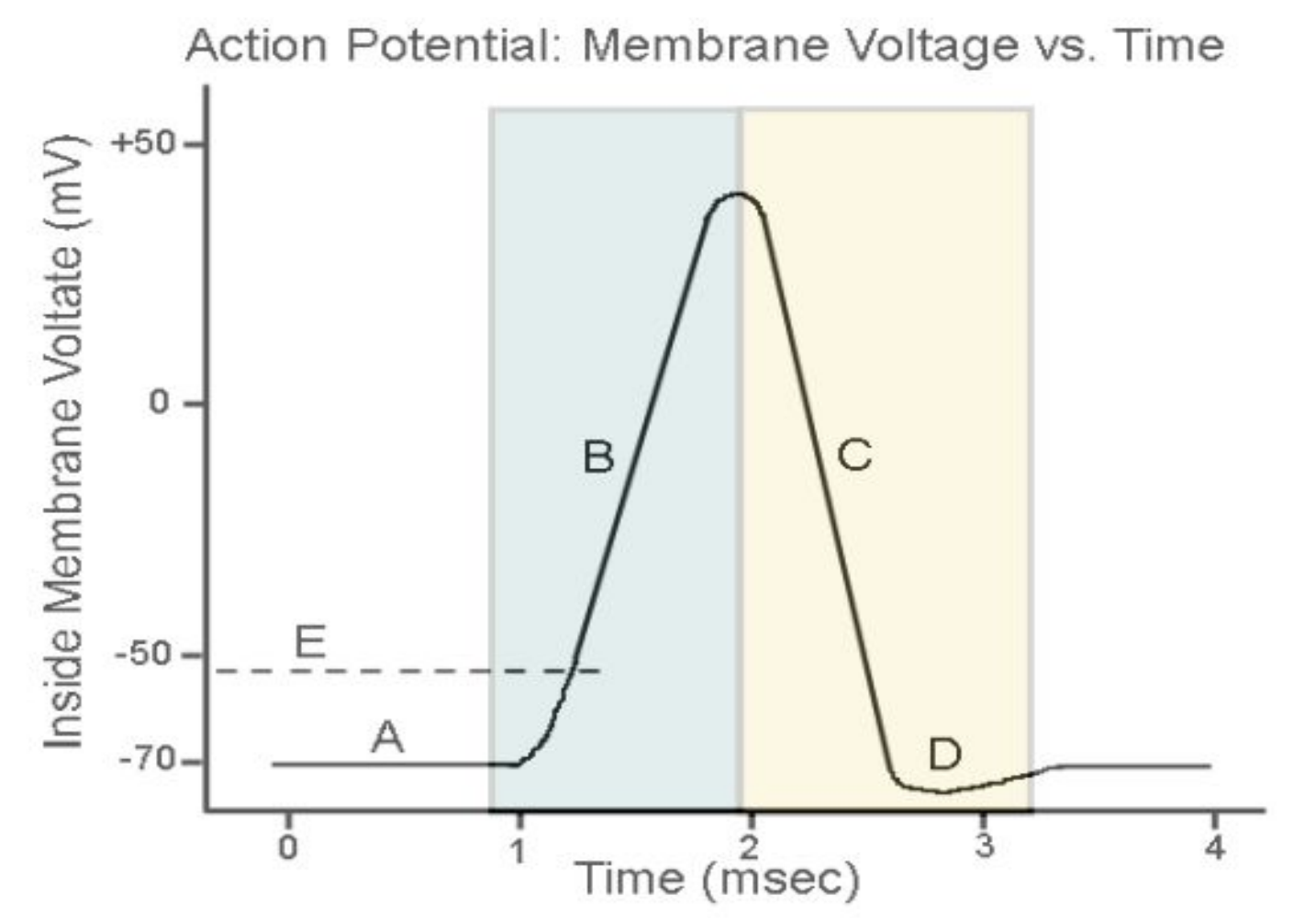
D
Hyperpolarization
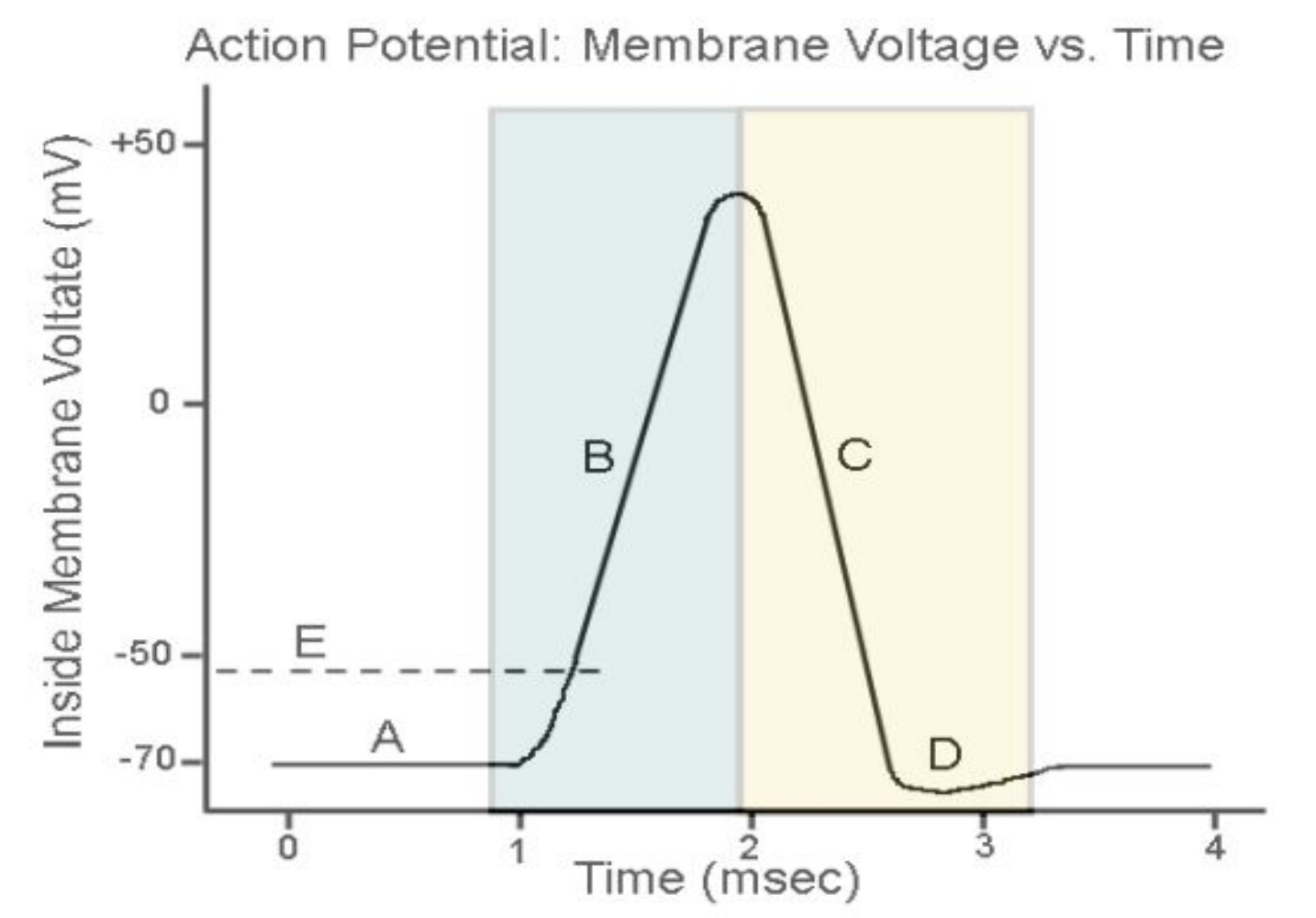
E
Threshold level
Describe depolarization (parts at work, movement of ions, charge of inner membrane and ECF).
The proton pump is pumping 3 Na+ out the cell for every 2 K+ into the cell. A stimulus of sufficient strength will cause Na+ channels to open inside the neuron, causing sodium to rush in. A reversal of charge happens, making the inner membrane more positive than the ECF
Describe repolarization (parts at work, movement of ions, charge of inner membrane and ECF).
The proton pump is pumping 3 Na+ out the cell for every 2 K+ into the cell. When the inner membrane of the neuron becomes positive, the Na+ channels close and the K+ channels open. K+ ions diffuse out of the neuron until the ECF is more positive than the inner membrane again
Why does hyperpolarization happen?
There are more K+ gates than Na+ gates, causing the K+ gates to close slower. Thus, more K+ diffuses out of the cell than necessary, causing the inner membrane to be more negative than at resting potential
How is the overshot charge of the inner membrane from hyperpolarization reverted to the resting potential?
The proton pump will continuously pump 3 Na+ out of the cell and 2 K+ inside the cell. Eventually, this will even out the overshot charge to the resting potential
Will a nerve fire during the refractory period?
No, the membrane must return to rest until another action potential is generated
How does an action potential move along the cell membrane?
In a cascade/domino manner:
Na+ rushes in, causing depolarization of the membrane, starting an action potential
Adjacent opposide charges are then attracted to each other, causing an electrical stimulus which triggers an action pottential next to the first one
This process repeats, with each action potential completing
Why do nerve impulses travel faster in myelinated nerves than in unmyelinated nerves?
On sections where the axon is covered in myelin, there are no ion channels and pumps. Thus, these spaces are skipped, reducing the distance that is needed to be travelled. Action potentials are only generated at Nodes of Ranvier, significantly speeding up nerve impulses
Compare action potentials for myelinated and unmyelinated nerves.
The action potential for myelinated and unmyelinated nerves are the same because there is no change in charge from myelinated sections. The distance is just less, making the speed faster
When will nerves respond to a stimulus?
A stimulus above a threshold level will produce a response. Anything below will not
Above the threshold level, does the strength of the stimulus matter?
No, whether the stimulus is strong or very strong above the threshold level, the strength of signal transmission is the same
What is the strength of an impulse determined by?
Frequency
What is the process of a synaptic transmission?
An impulse reaches the synapse from the axon, opening calcium channels which cause calcium ions to diffuse into the pre-synaptic neuron
The calcium influx stiumlates synaptic vesicles to move to the pre-synaptic membrane
Synaptic vesicles dump neurotransmitter substance into the synaptic cleft
The neurotransmitter substance diffuses across the synaptic cleft
The neurotransmitter substance fits into receptor sites on the postsynaptic membrane
An action potential is stimulated at the postsynaptic membrane and an impulse travels down the dendrite
An enzyme destroys the neurotransmitter substance and clears out the synaptic cleft
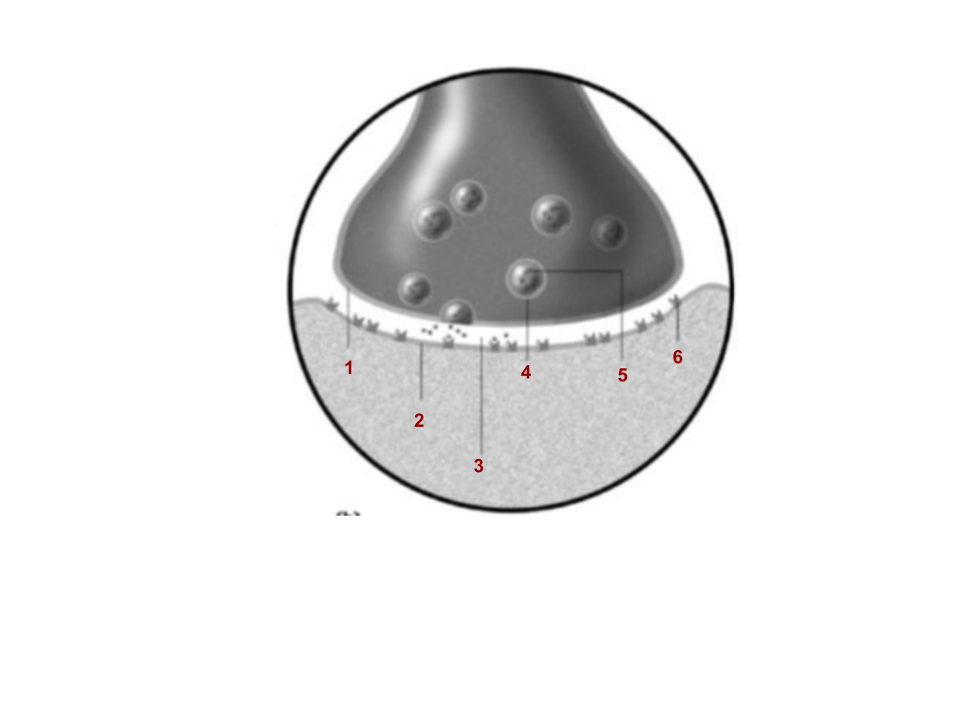
1
Presynaptic membrane
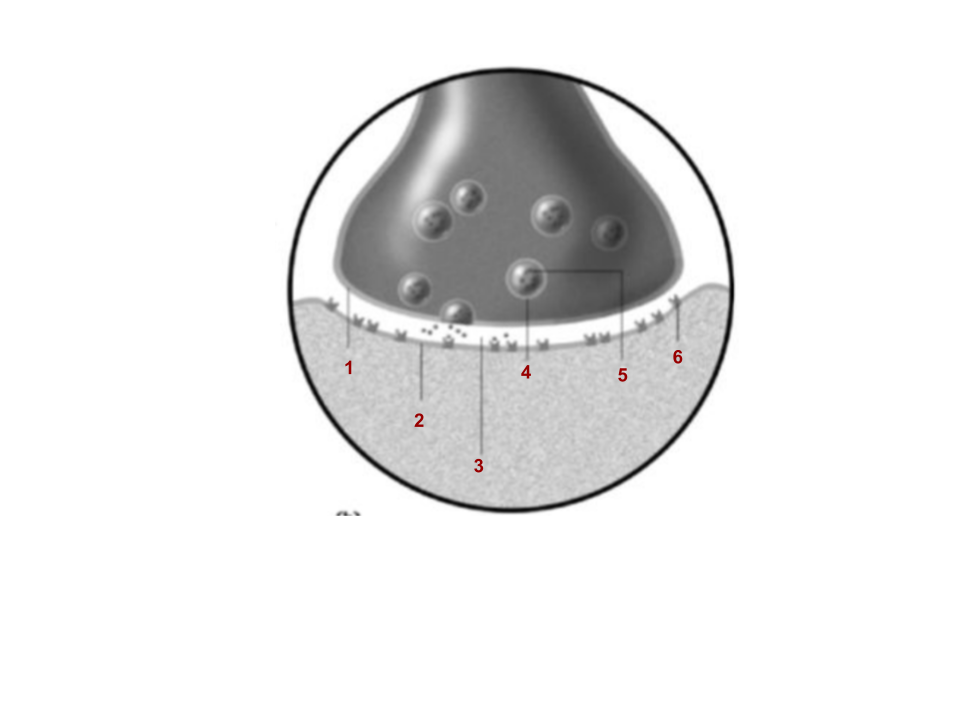
2
Postsynaptic membrane
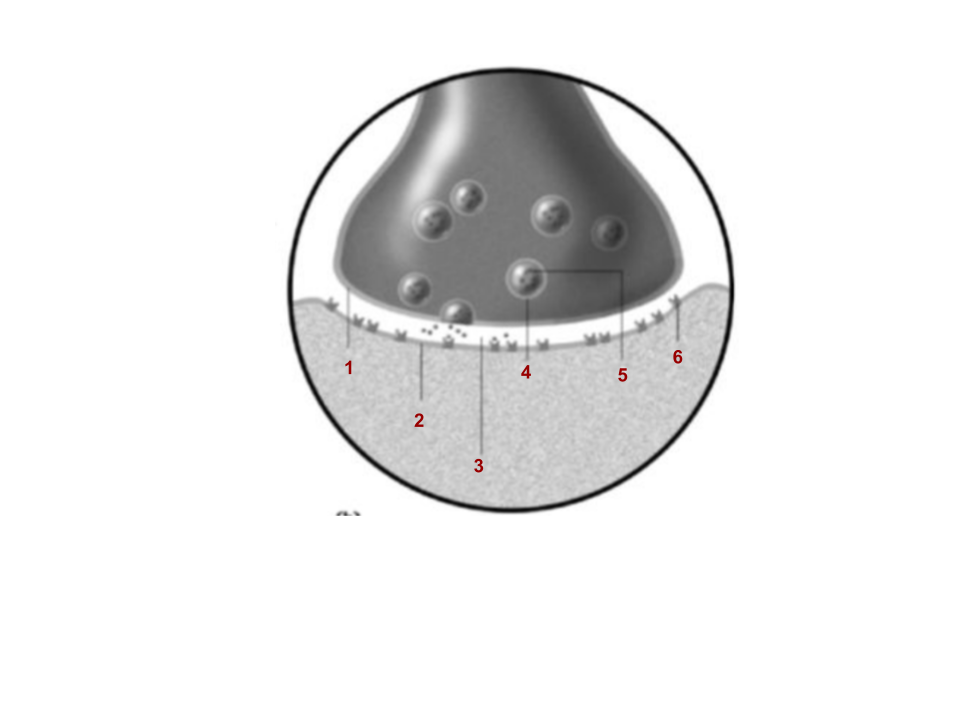
3
Synapse
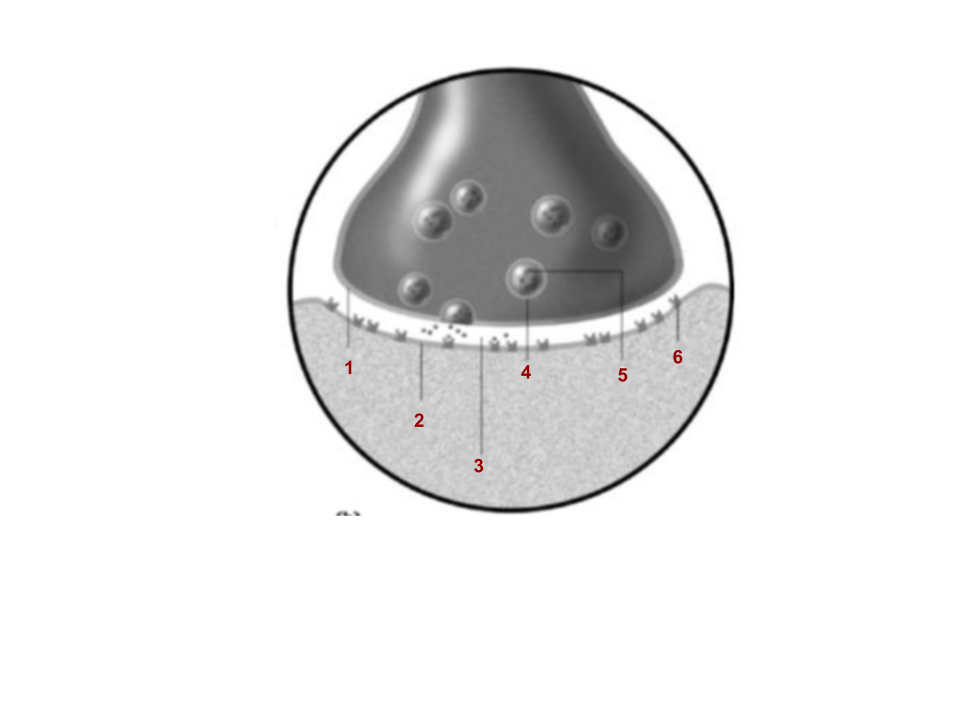
4
Vesicle
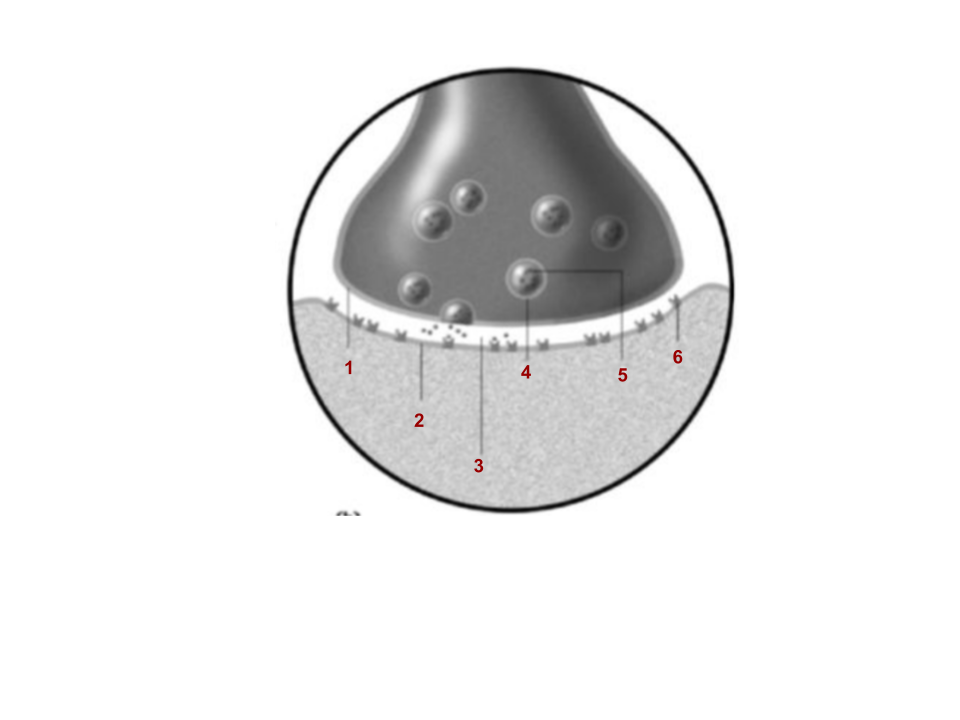
5
Neurotransmitter
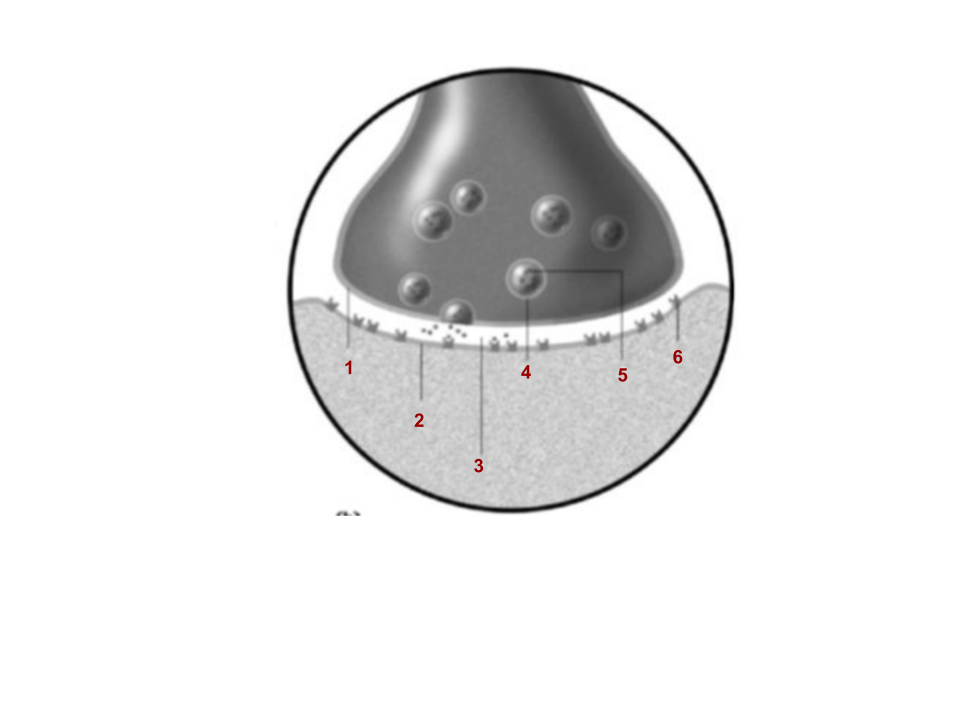
6
Receptor
By what process do neurons release neurotransmitter substance?
Exocytosis of vesicles
Why is an enzyme to remove the neurotransmitter required once a signal is transmitted?
Neurotransmitter remaining in the receptor site would cause the neuron to fire repeatedly, eventually leading to its failure. Thus the synapse needs to be cleaned in order to ensure a signal is transmitted at the correct time
What are the different forms of protection for the CNS?
Bone (skull, vertebrae), meninges, cerebrospinal fluid
What is the main function of the spinal cord?
Carries sensory neurons from receptor to brain and carries motor neurons from brain to effectors
What are the three regions of the brain?
Forebrain, midbrain, hindbrain
What are the parts of the forebrain?
Thalamus, hypothalamus, cerebrum
What are the right and left hemispheres of the cerebrum in charge of, respectively?
Right: creative thought. Left: logical thought.
What are the four lobes of the cerebrum?
Frontal lobe, temporal lobe, parietal lobe, occipital lobe
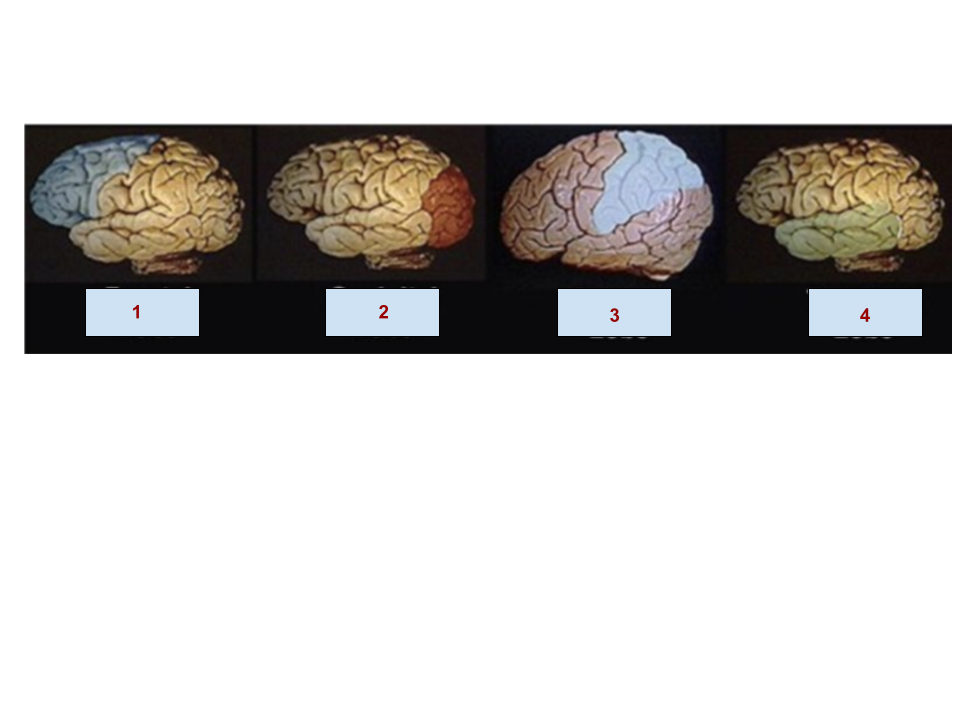
1
Frontal lobe

2
Occipital lobe
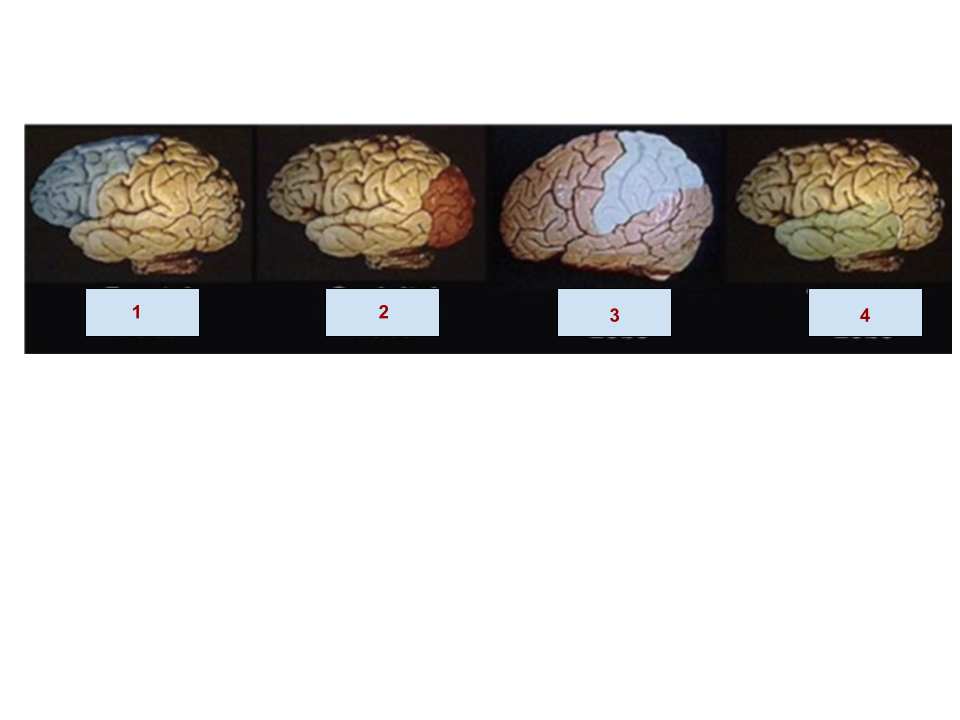
3
Parietal lobe
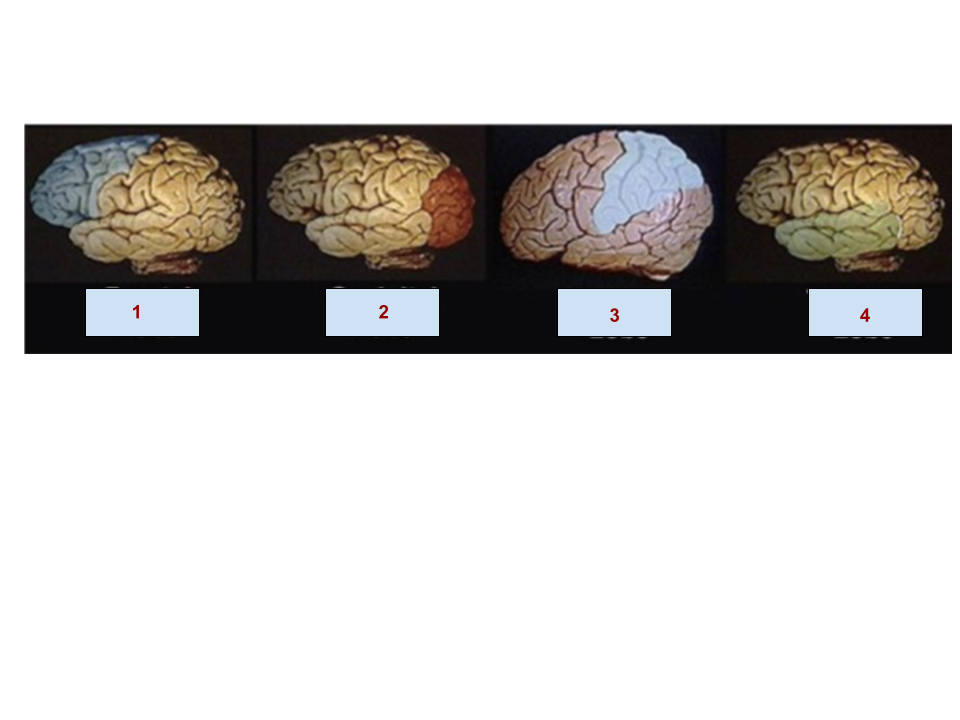
4
Temporal lobe
What are the parts of the hindbrain?
Cerebellum, pons, medulla oblangata
Why does the right side of the brain control the left side of the body and vice versa?
Motor axons from the mid and forebrain cross from one side of the CNS to the other side at the hindbrain
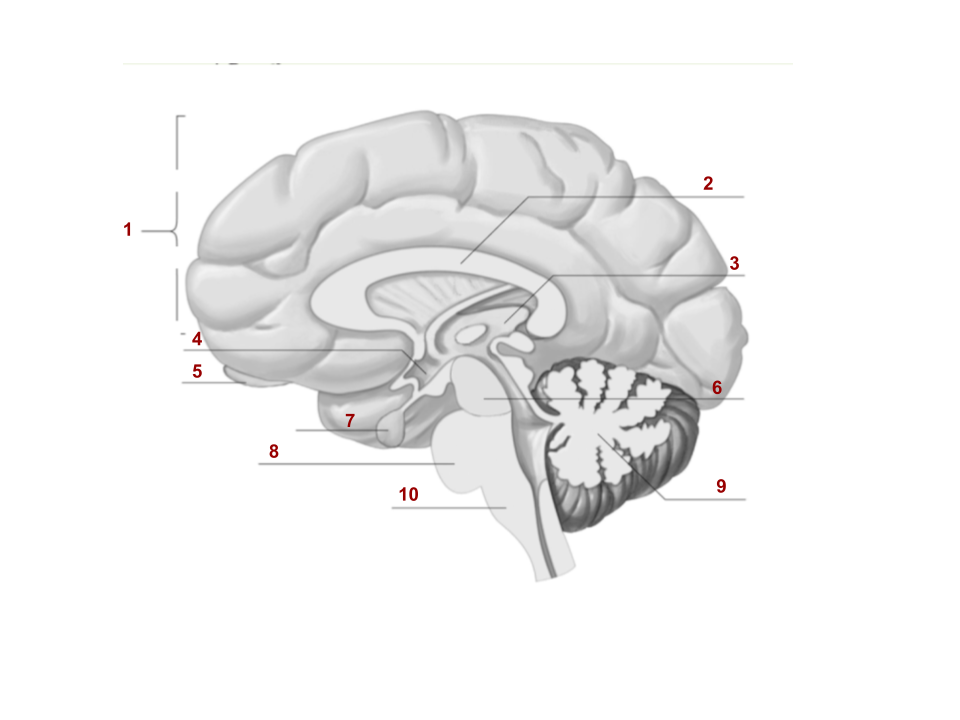
1
Cerebrum
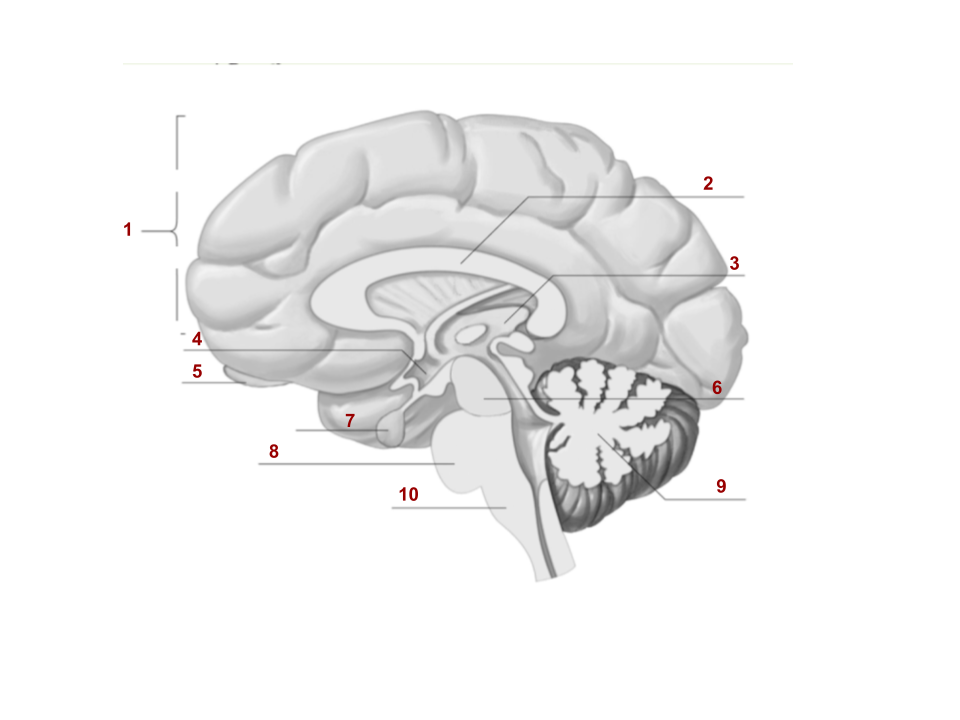
2
Corpus callosum
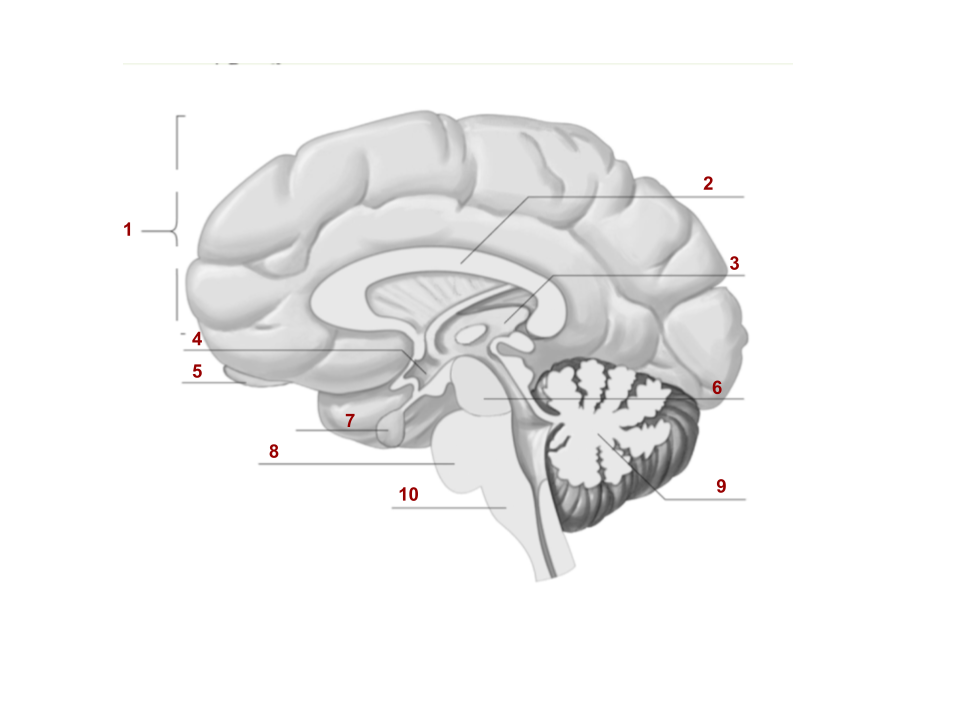
3
Thalamus
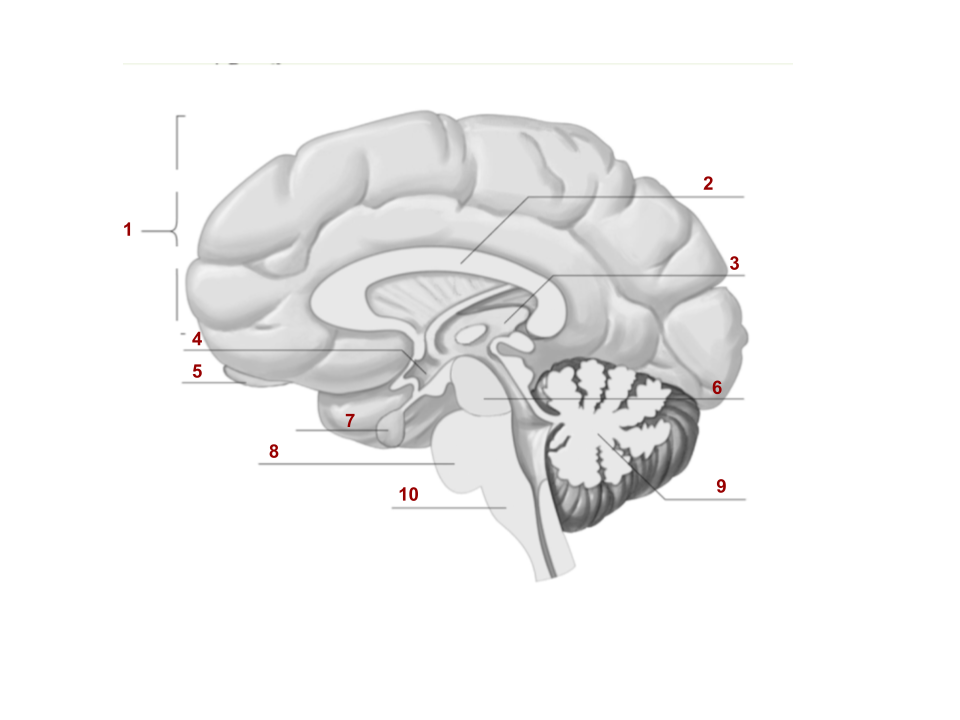
4
Hypothalamus
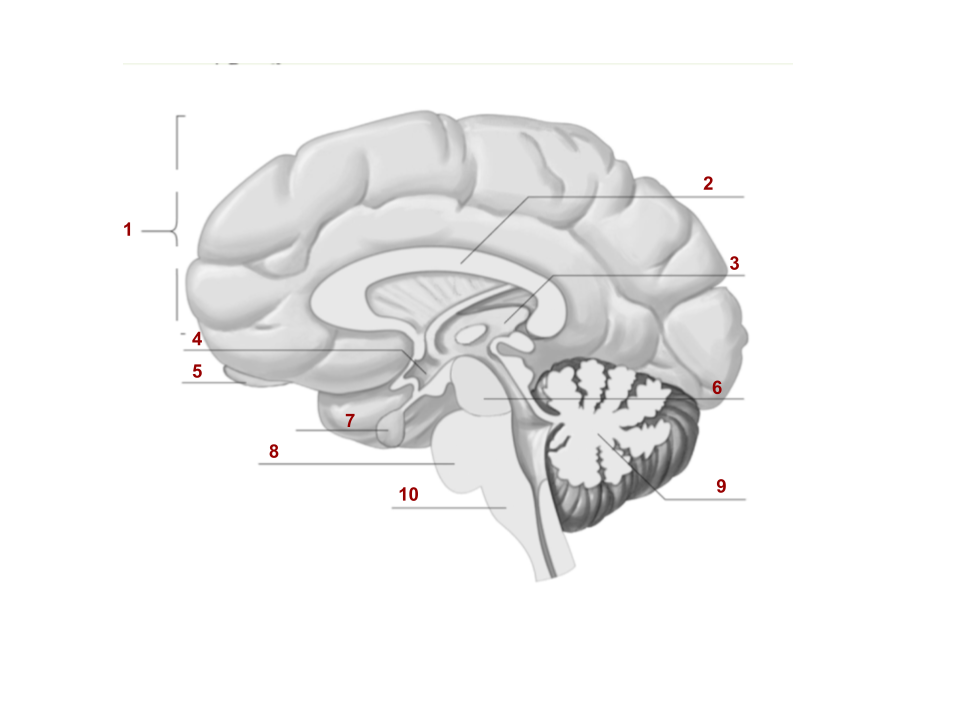
5
Olfactory bulb
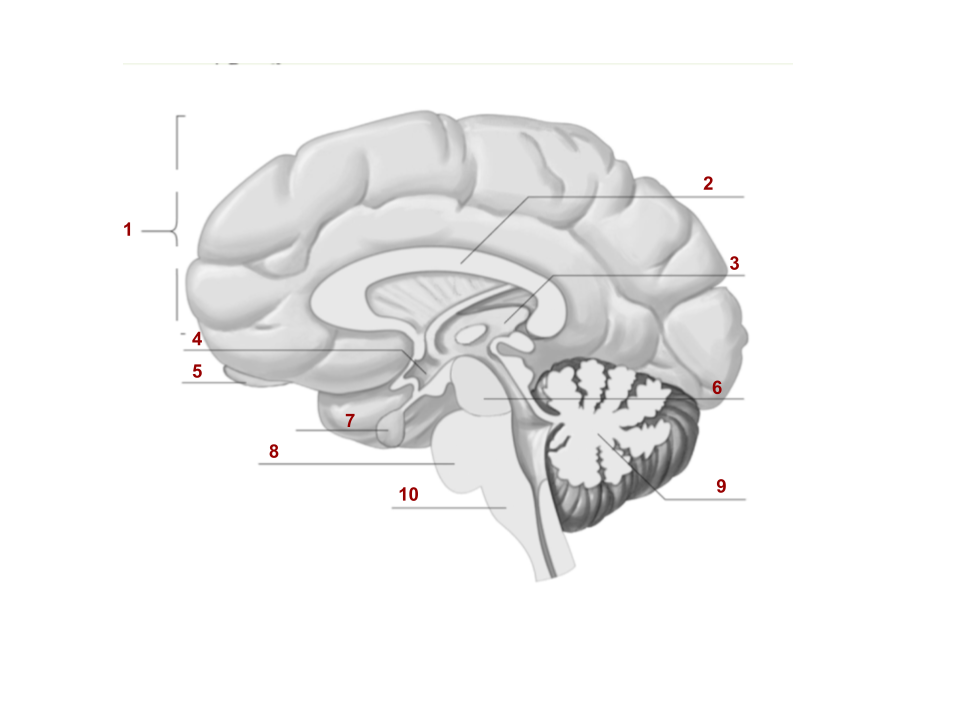
6
Midbrain
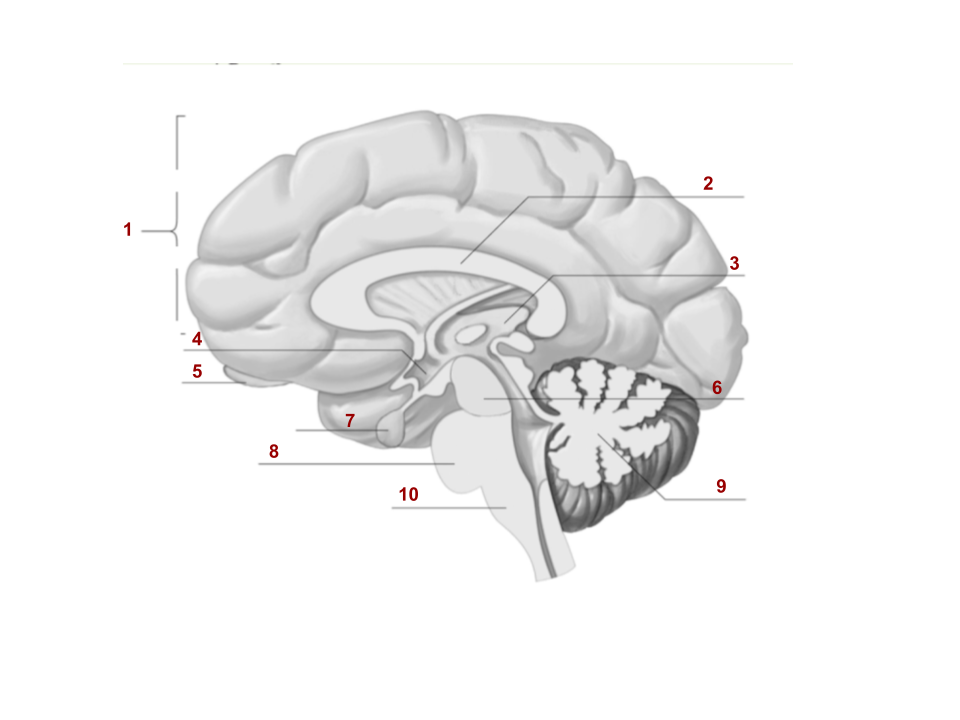
7
Pituitary gland
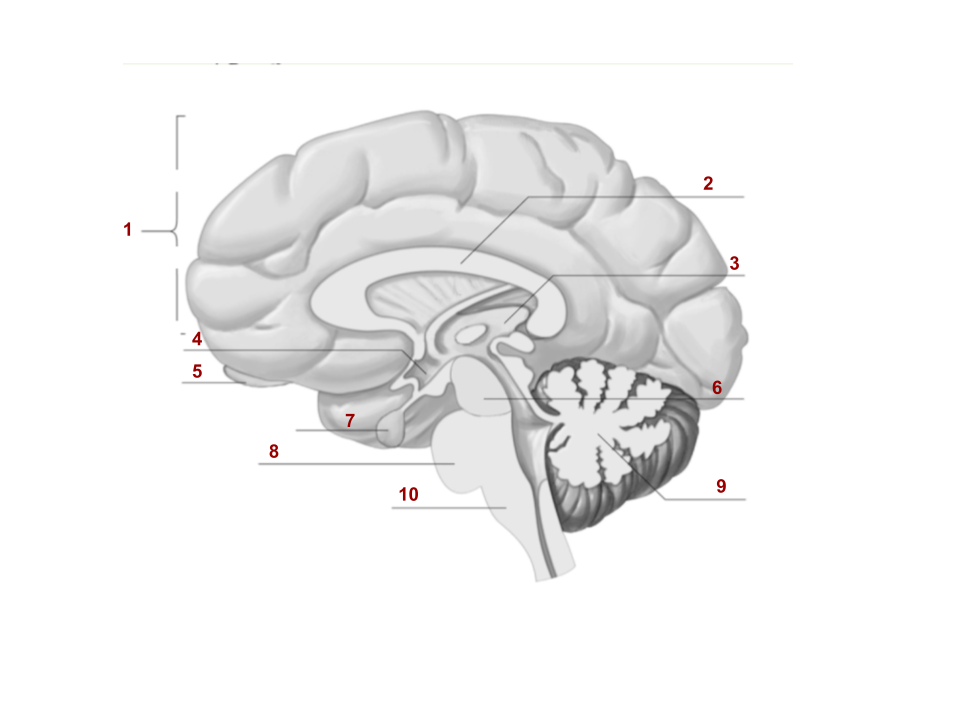
8
Pons
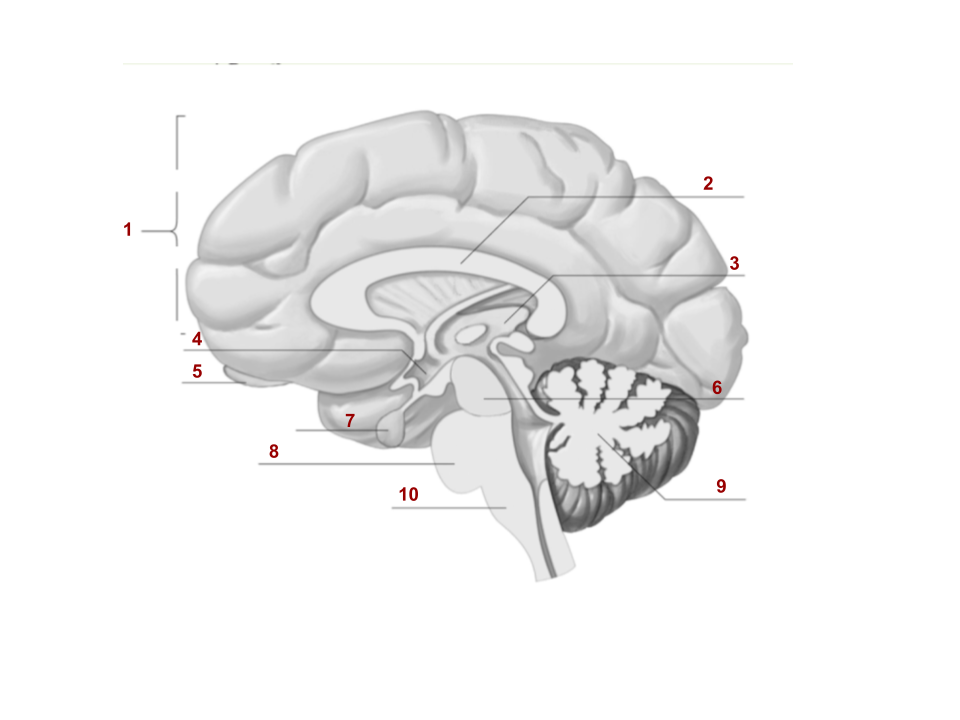
9
Cerebellum
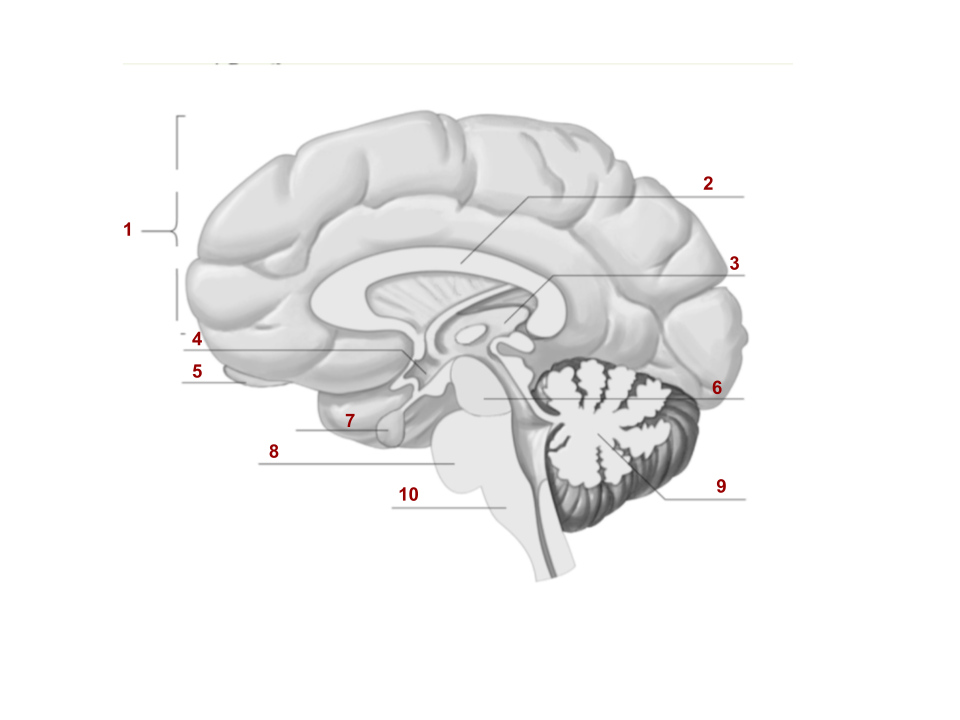
10
Medulla oblangata
What are the two divisions of the PNS?
Sensory-somatic nervous system, autonomic nervous system
What are the two units of the autonomic nervous system?
Sympathetic nervous system, parasympathetic nervous system
What are the effects of the sympathetic nervous system on the eyes, digestive system (mouth and stomach), lungs, heart, liver, adrenal gland, and excretory systems (rectum and bladder)?
Dilates pupil, inhibits salivation and persistalsis, relaxes bronchi, accelerates heart rate, releases glucose, releases epinepherine, relaxes bladder and contracts rectum
What are the effects of the parasympathetic nervous system on the eyes, digestive system (mouth and stomach), lungs, heart, liver, adrenal gland, and excretory systems (rectum and bladder)?
Contracts pupil, promotes salivation and persistalsis, contracts bronchi, inhibits heart rate, stores glucose, no epinepherine released, contracts bladder and relaxes rectum
When do the divisons of the autonomic nervous system activate?
The sensory system controls the body based on its perception of the stimulus and activates what is necessary

1
Brain
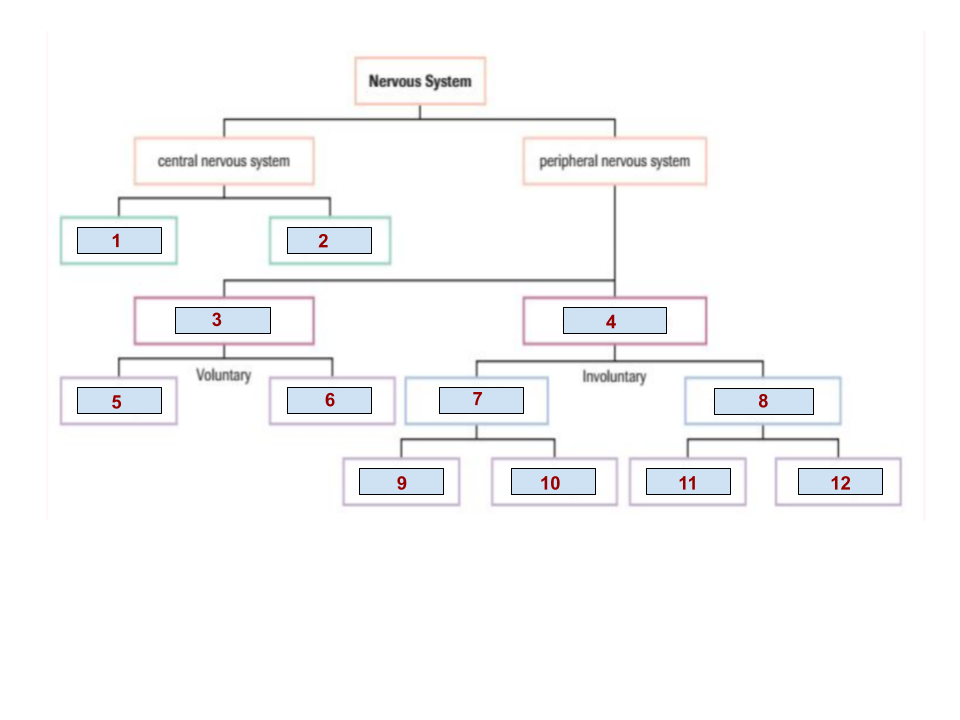
2
Spinal cord
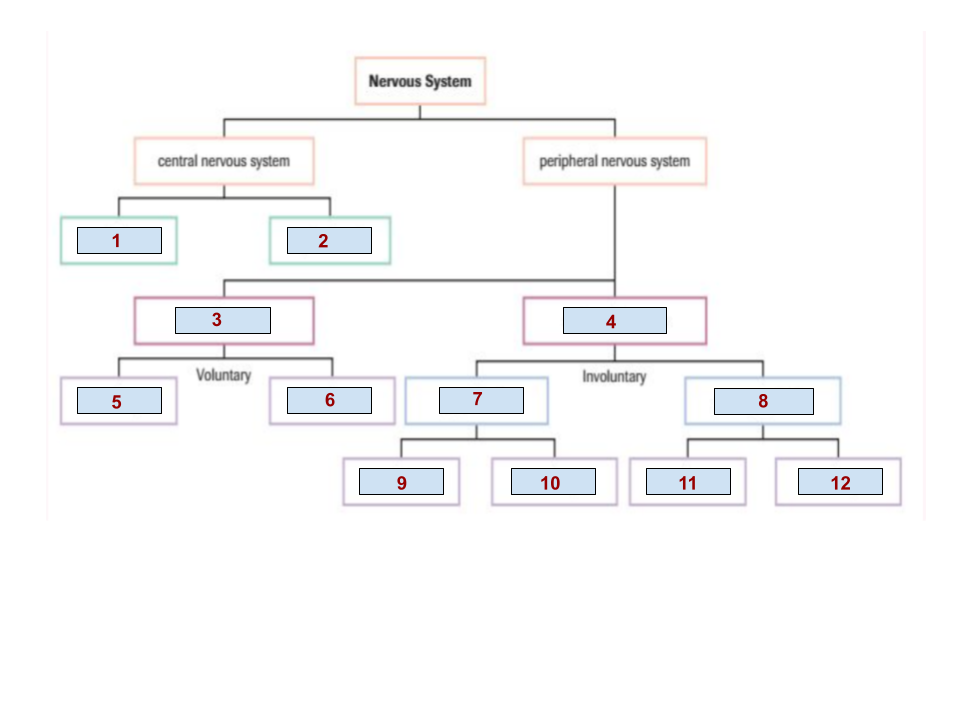
3
Sensory-somatic nervous system
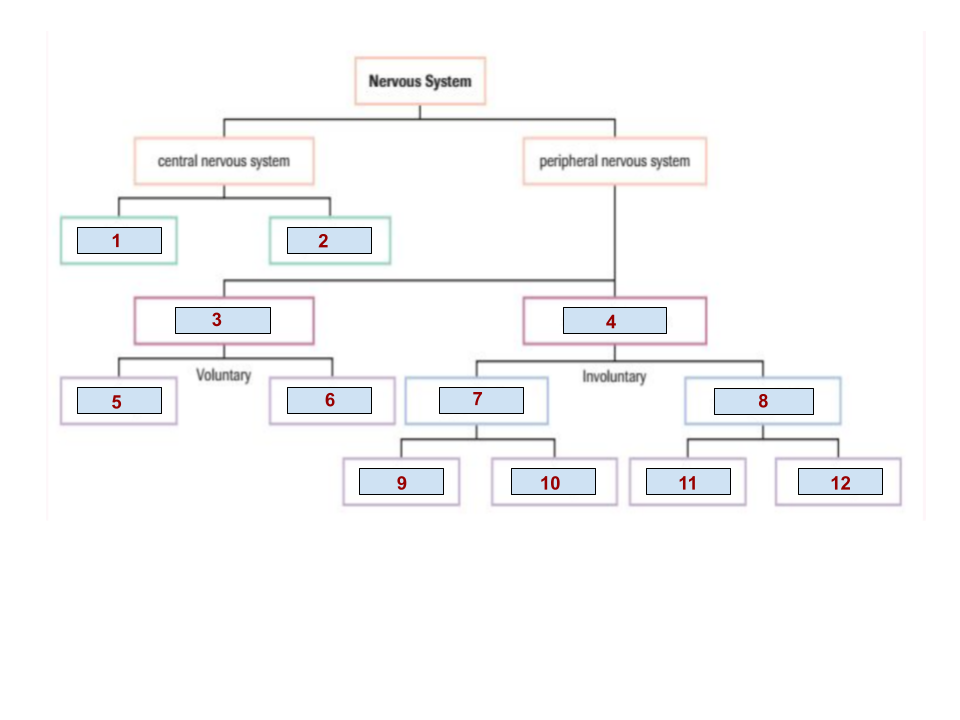
4
Autonomic nervous system
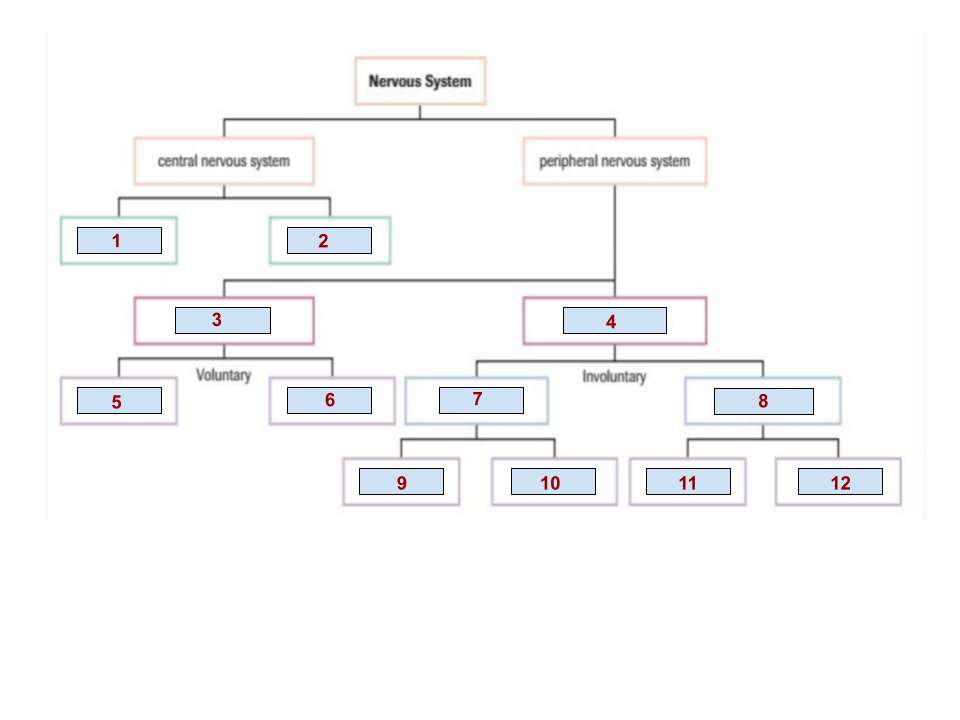
7
Sympathetic nervous system
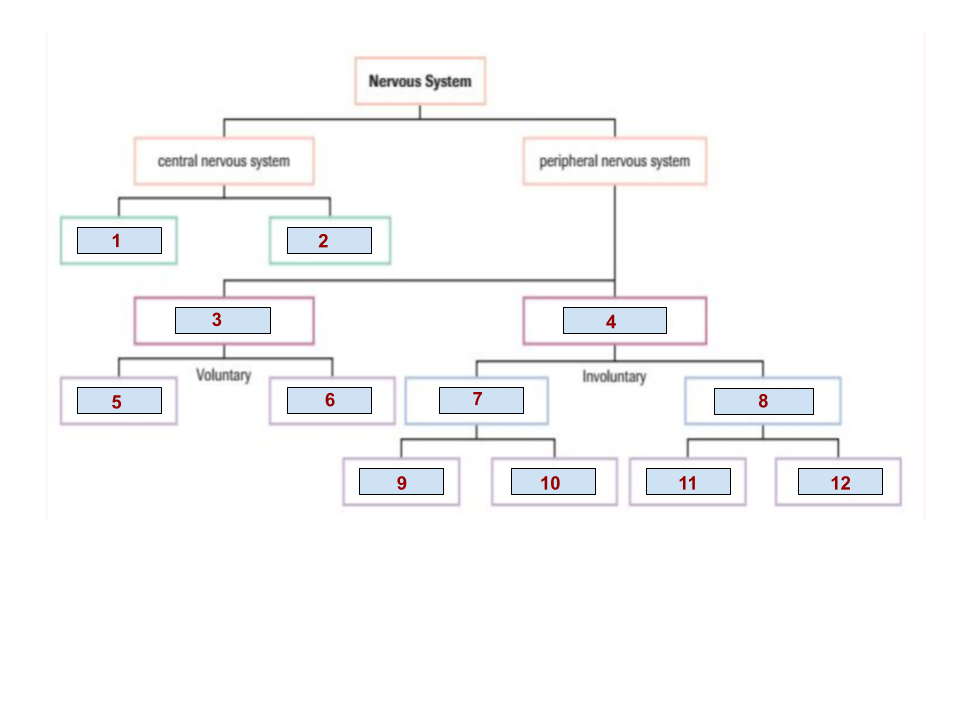
8
Parasympathetic nervous system